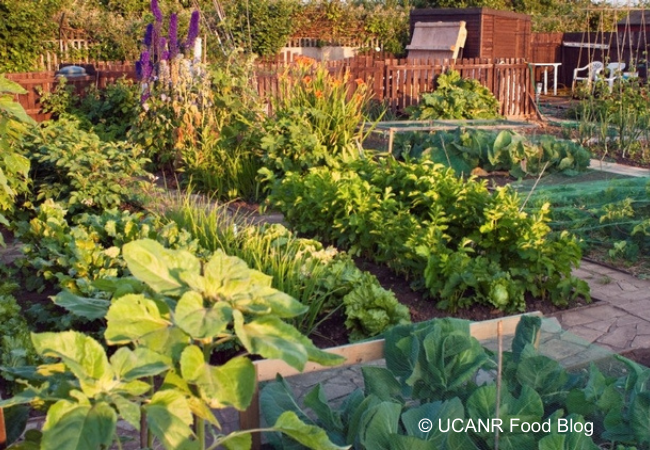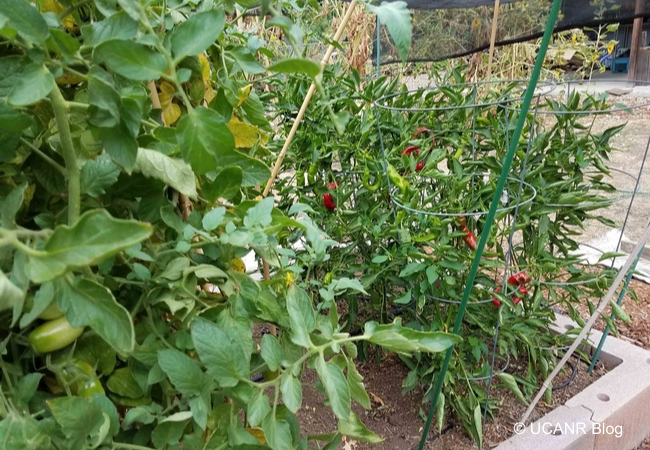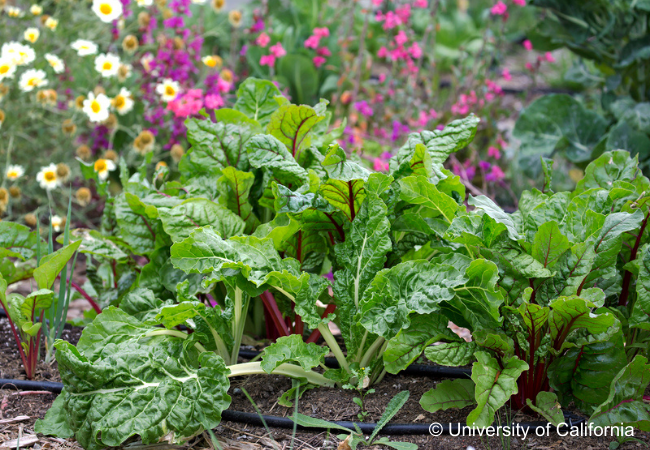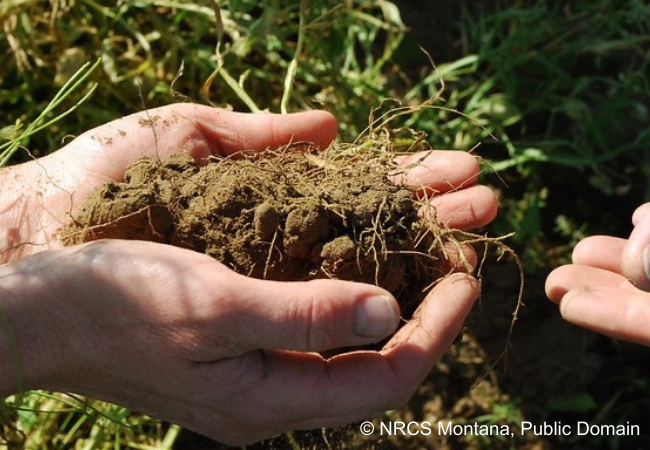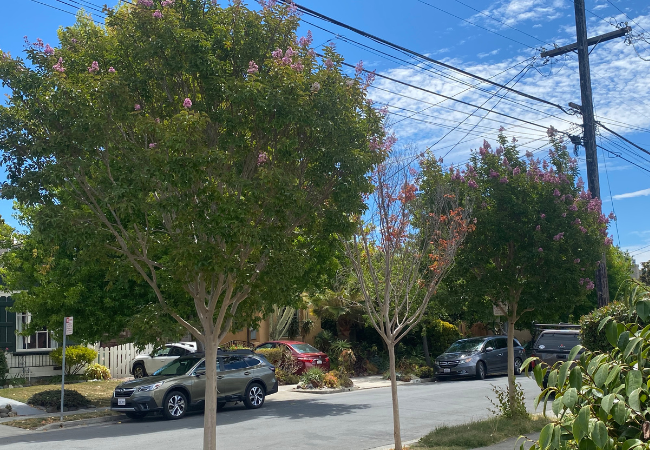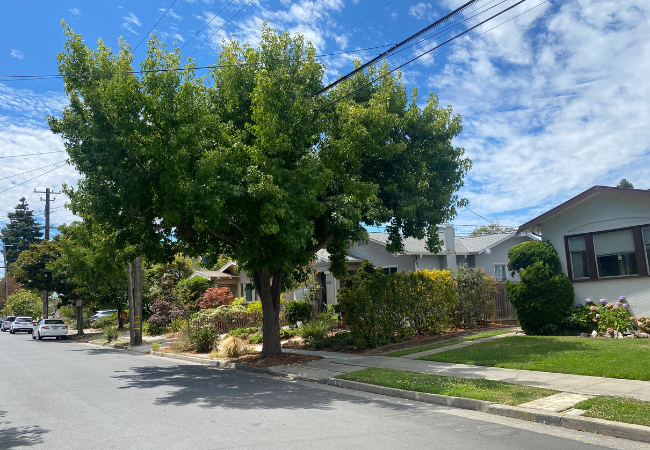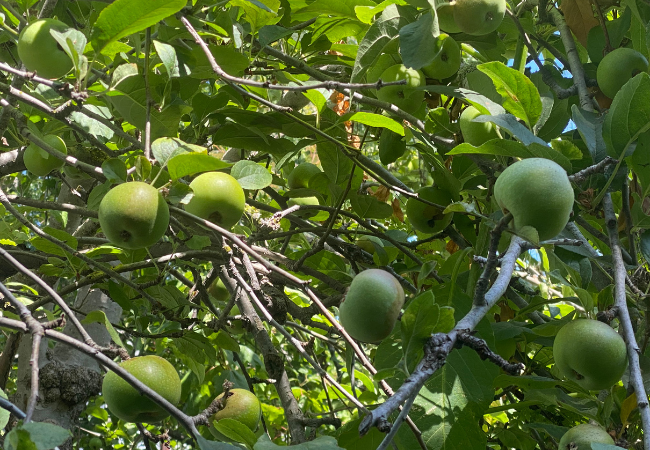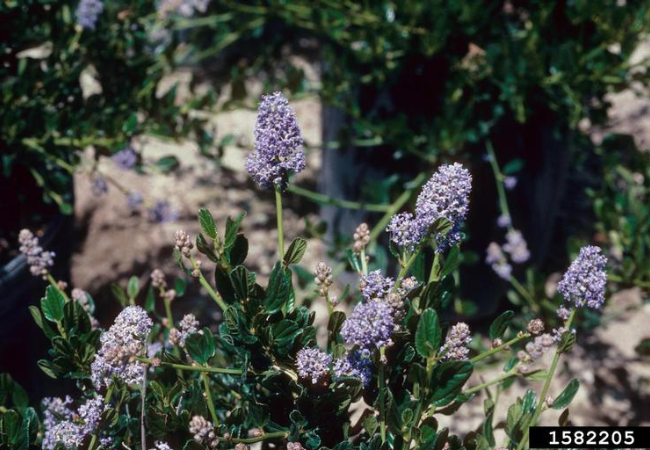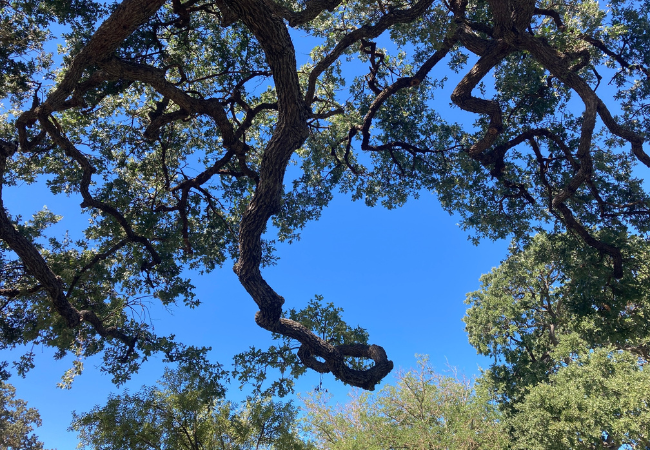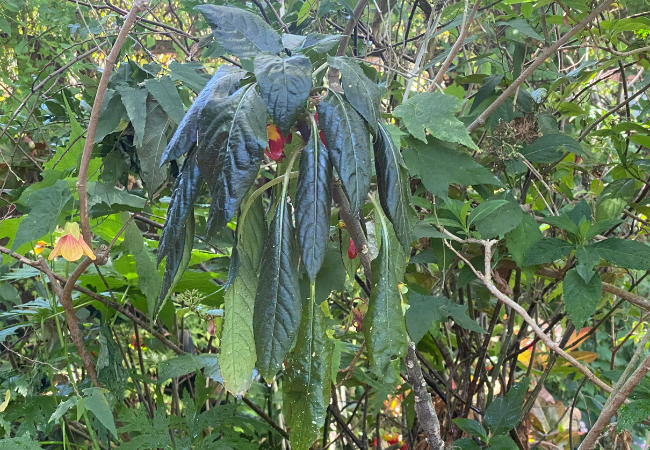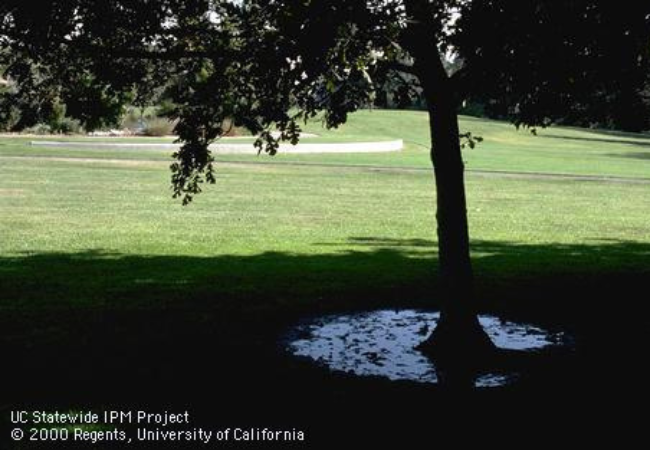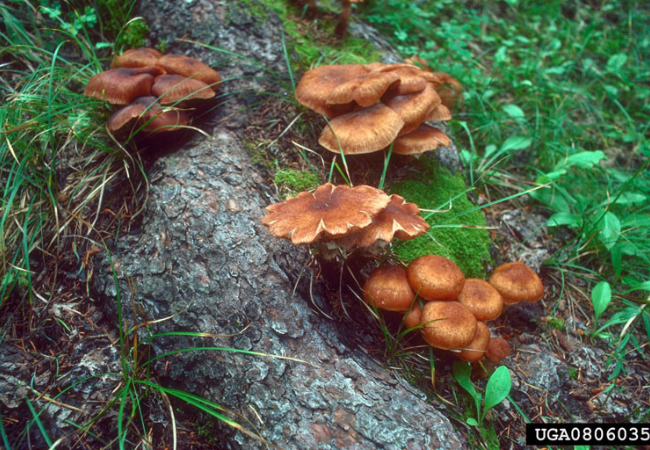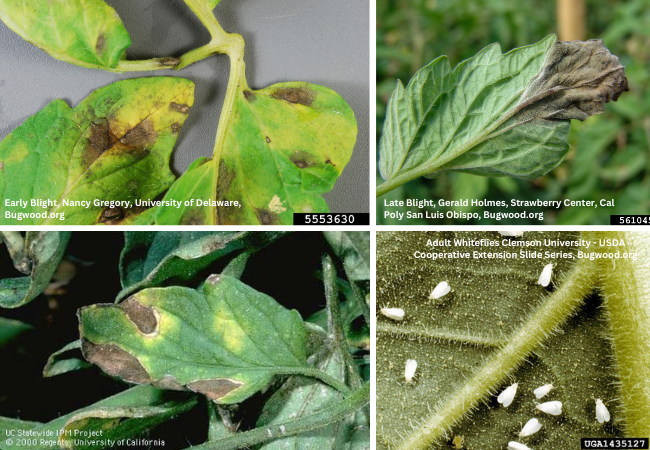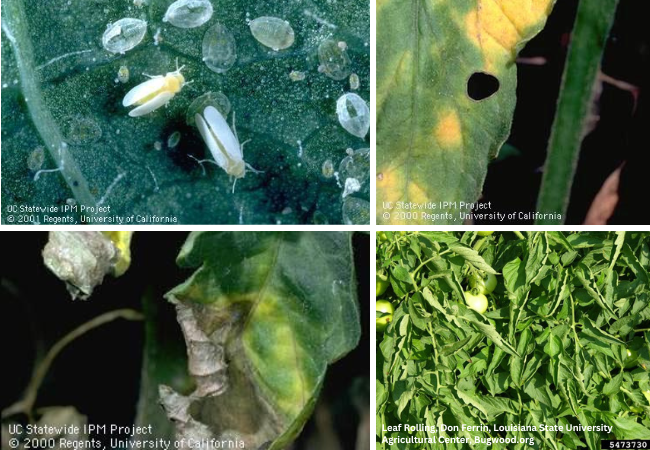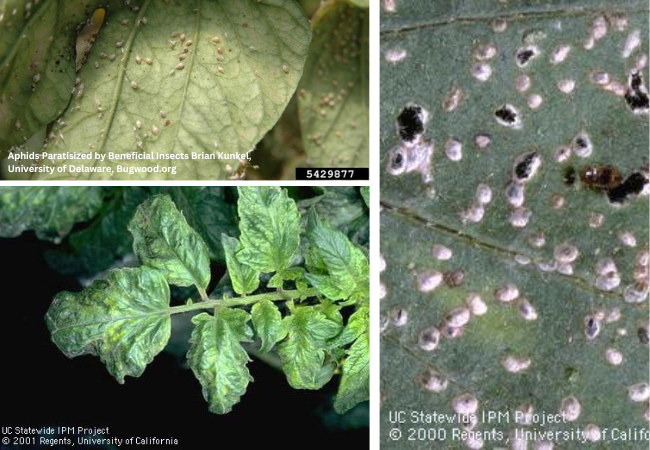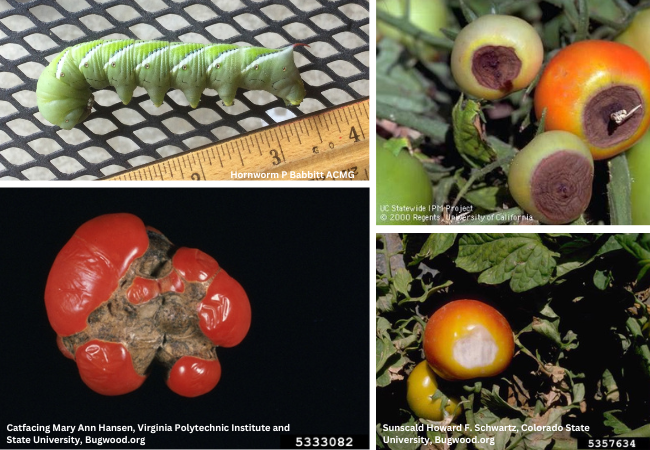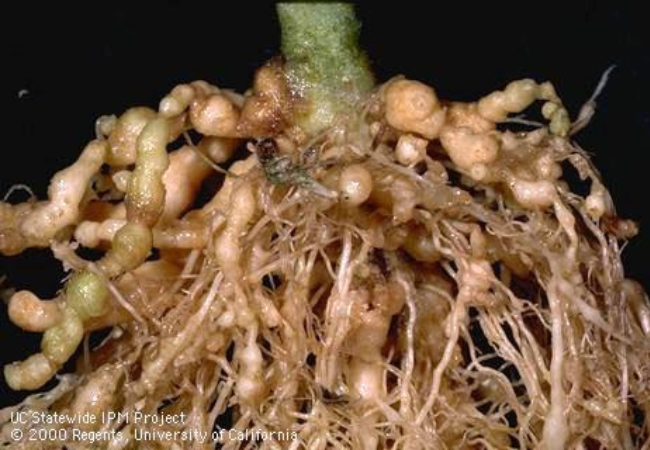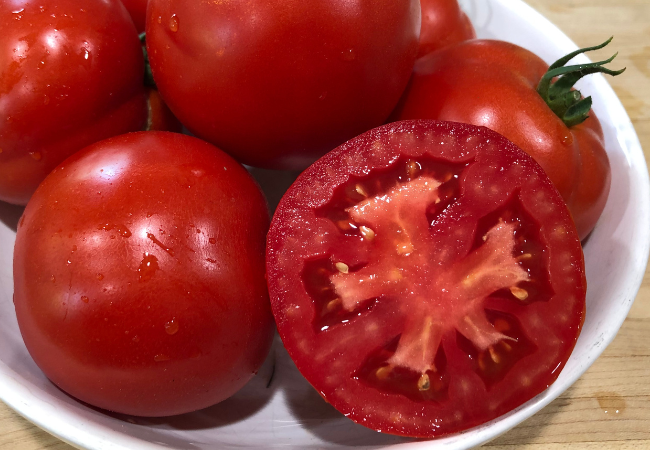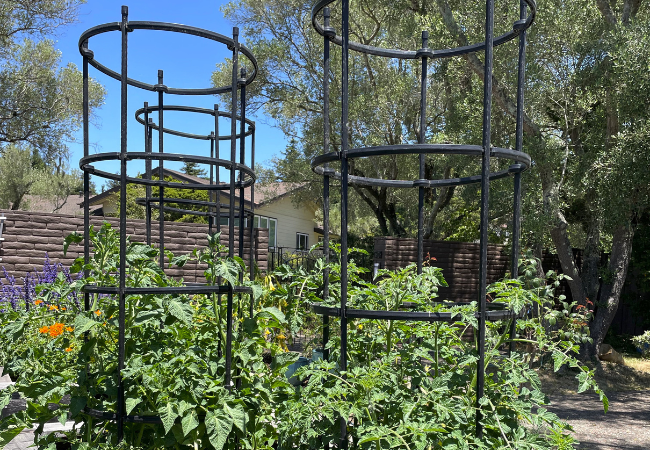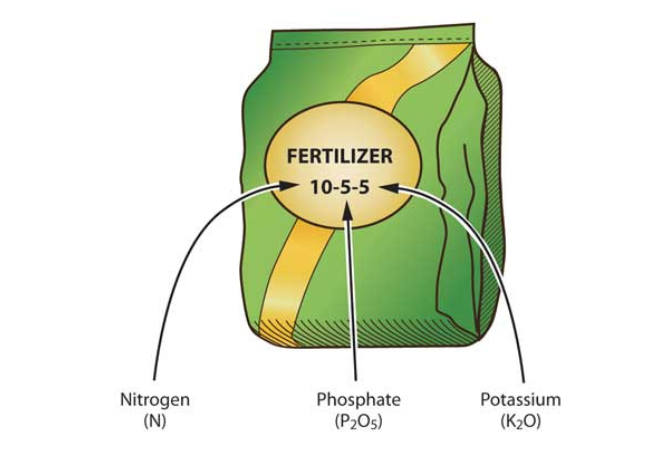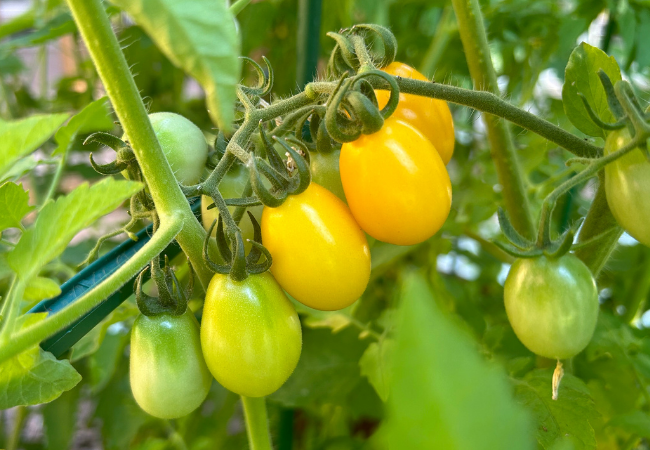- Author: Judy Quan
(Case study: The Mediterranean Fruit Fly in Alameda County, Sept. 2024)
Invasive Species are either here or on their way.
Invasive species threaten California's home gardens and more importantly California's agriculture, ecology and environments. Invasive species are non-native (or exotic) species whose introduction is likely to cause economic or environmental harm, or harm to human health. There are infestations that require an immediate and rapid response to eradicate the pest before it can become established. The discovery of the one wild mated female Mediterranean fruit fly in Alameda County prompted such a response, showing the high priority of eradicating what is considered to be the world's most destructive agricultural pest before it can establish itself in California.
Some other invasives are already established in California, and some we are on the watch for, knowing there is a high likelihood of them being detected in California. Some are present in Southern California and we are on alert for them making their way to our counties here in Northern California.
This blog series focuses on a few invasives, mostly plants and insects, but there are also invasive fish, mammals and birds. The invasive exotic (non-native) fruit flies – Caribbean, Guava, Mediterranean, Melon, Mexican, Olive, Oriental, Peach and others – are all serious threats to home gardeners and the agricultural economy. Asian Citrus Psyllid and Huanglongbing Disease, Invasive Shothole Borers, Tree-of Heaven, Brown Marmorated Stinkbug, European Grapevine Moth, and Spotted Lanternfly are just some of the invasives that California is monitoring for their appearance or spread in California.
Invasive Plants and Pests: Major Threats to California's Agriculture, Home Gardens and Environments
In some cases, non-native plants and pests become serious pests, while others blend in and do not cause noticeable problems. California is on the lookout for non-native invasive species that result in economic costs in order to:
- control invasives
- reduce rate of spread
- inspect agricultural products to prevent accidentally moving invasives to new areas.
In addition, financial costs to farmers to control pests, often with pesticides, results in higher food prices for the consumer. The economic threat can be to agriculture generally or to growers of specific crops such as grapes or citrus.
There are also additional risks to the environment:
- Upset to the ecosystem, crowding out native plants and animals
- Greater chance of wildfires, with greater intensity
- Depletion of the water table
- Invasive plants can be preferred hosts for invasive pests (These non-native plants provide food and shelter particularly suitable for invasive pests, promoting uncontrolled population growth. The California environment lacks the predators from their native habitat that would normally keep the pest population manageable.)
- There are costs to ornamental trees dying because of pests and then needing to be removed
In California, at least $3 billion is spent annually on eradicating invasive pests, according to the University of California at Riverside.
How Invasives Arrive and Become Established
Invasive species are spread by human activity, often unintentionally. Now, with the ease of travel nationally and internationally, there is greater potential for exotic or non-native species to arrive unnoticed. Rapid transportation makes it likely that accidental hitchhikers survive long distance travel. Ornamental plants, along with hitchhiking insects, can become invasive after escaping into the wild. Insects can be unintentionally transported and spread to new areas when they or their eggs are on things, such as plants, plant material, vehicles, wood, that are moved. The diversity of climates and habitats in California can result in the right combination for exotic organisms to become established.
Invasive Plants Originating from the Nursery Industry
The California Invasive Plant Council (Cal_IPC) has a list of non-native invasive plants that either have already impacted natural areas or are at high risk of becoming invasive, damaging wildlife habitat, degrading food and water supply and more. Many of these plants were intentionally introduced by the nursery industry as ornamental landscape species. According to the UC IPM Pest Note on Invasive Plants, about 60% of the species listed were intentionally introduced, and most of that 60% came through the nursery industry as ornamental landscape species.
Management of Invasives
The Mediterranean fruit fly (the medfly) is an example of how invasives can be managed. In September 2024, one mated female was found in Alameda County. This fly is known to target over 250 fruits and vegetables. The fly causes damage when females lay eggs in the produce. The eggs hatch into maggots that burrow through the produce making it unfit for sale or consumption. The Medfly is considered to be highly invasive but is not yet established in California. It has the potential to have a devastating effect on agriculture and home gardens,so there will be a concerted, coordinated plan to eliminate the Medfly.
Proactive Management - Quarantines, Inspection, Bans on Imports or Sales
Management of invasive species may be proactive, focusing on the exclusion of the pest. Exclusion management uses quarantine laws, the inspection of imports for hitch-hikers, and the banning of import or sale of certain plant and animal species. If detected at a very early stage of invasion, the goal will be to eradicate the pest, as it is currently being done with the fruit flies, including the Mediterranean fruit fly pictured below.
The Mediterranean fruit fly - Proactive Management in Action
The September 2024 discovery of a single mated female Mediterranean fruit fly in Fremont resulted in a quarantine of 71 square miles in southern Alameda County, now expanded to 83 square miles. The California Department of Food Agriculture (CDFA) announced the quarantine, the first in Alameda County since 1981. View the quarantine map. The quarantine affects growers, wholesalers and retailers of susceptible fruit, as well as local residents.
An invasive fruit fly quarantine , what does it mean for home gardeners?
- Check to see whether you are in the quarantine area
- Home gardeners are encouraged to consume their own fruits and vegetables, and not move produce from their properties.
- Do not compost your fruits and vegetables.
- When disposing of produce, double-bag the waste and put it into the trash instead of the green waste bin.
- Don't let ripe produce fall to the ground.
- Inspect your garden for signs of invasive fruit flies or maggots.
- If you think your fruits and vegetables may be infected with fruit fly larvae, call CDFA's Pest Hotline (800) 491-1899 or reportapest@cdfa.ca.gov
How else can Californians help with the Medfly?
- The majority of fruit flies and other invasives are found in urban and suburban communities. The most common pathway for these invasive species to enter our state is by “hitchhiking” in fruits and vegetables brought back illegally by travelers as they return from infested regions of the world.
- To help protect California's agriculture and natural resources, CDFA urges travelers to follow the Don't Pack a Pest program guidelines (https://www.dontpackapest.com/)
- Buy fruit trees and vegetable plants from licensed California nurseries.
What else is being done to eradicate the Medfly?
In the case of the Mediterranean fruit fly, the plan to eliminate the pest uses the standard Medfly program by the CDFA and is the safest, most effective, and most efficient response program available. Sterile male fruit flies will be released in a 39-square-mile area around the infestation at a rate of 250,000 male fruit flies per square mile per week. The sterile males mate with the female fruit flies but do not produce offspring. The goal is to leave no new fruit flies to replace the wild ones as they reach the end of their short lives.
In addition, an organic form of Spinosad is being used to treat properties within 200 meters of the detection site to reduce the population of fruit flies. Fruit removal will take place on properties within 100 meters of those with mated females, larval detections and multiple adult detections.
Reactive Management - Do Nothing, Cultural, Chemical, Biological Controls; or Integrated Pest Management (IPM)
Another approach is reactive management where exclusion and eradication is impossible. This is used when an invasive species has successfully invaded and high populations are now spread over large areas.
Options include:
- do nothing, where there is no management plan in effect, as is often done with invasive weeds in national, state or county parks
- use cultural controls, such as crop rotation, use of plants resistant to specific plant disease, or mulching to promote growth of beneficial organisms
- use chemical controls (pesticides), which are often expensive, need repeated applications, and they may leave pesticide residues leading to human safety concerns
- use biological controls, which involve the use of natural enemies (predators, parasitoids and pathogens) of the invasive species
- use integrated pest management which combines a variety of control strategies to control an invasive pest.
The Big Three Protecting California's Food Supply with Information, Detection, and more …
The US Department of Agriculture, the California Department of Food and Agriculture and the Agricultural Commissioners of each California county work together. They have services that gather and provide information on invasives, provide detection services and coordinate management of invasives.
1) U.S. Department of Agriculture
National Invasive Species Information Center (NISIC) was established in 2005 at the U.S. Department of Agriculture (USDA's) National Agricultural Library (NAL) to meet the information needs of users, including the National Invasive Species Council (Council or NISC).
The NISC provides "the high-level vision and leadership necessary to sustain and expand Federal efforts to safeguard interests of the United States by preventing, eradicating, and controlling invasive species, as well as restoring ecosystems and other assets impacted by invasive species."
invasivespeciesInfo.gov is managed by NISIC at NAL. This site serves as a gateway to invasive species information, including federal, state, local and international sources. It provides selected U.S. and International resources from agencies and organizations with an interest in the prevention, control, or eradication of invasive species, organized by geography.
2) California Department of Food and Agriculture
CDFA Plant Health and Pest Prevention - Border protection, Pests Detection and Exclusion, Quarantine Information and more
The California Department of Food and Agriculture (CDFA) has Plant Health and Pest Prevention Services to protect California's food supply from exotic pests. https://www.cdfa.ca.gov/plant/
CDFA early detection and eradication projects
It also has pest detection/emergency projects for the early detection and prompt eradication of serious agricultural pests from California. https://www.cdfa.ca.gov/plant/PDEP/
CDFA list of invasives
There is a list of insect pests and plant diseases targeted by the CDFA detection and emergency projects. The list includes Asian Citrus Psyllid and plant disease Huanglongbing (HLB), invasive fruit flies, Spotted Lanternfly
https://www.cdfa.ca.gov/plant/PDEP/target_pests.html
3) The Alameda County Department of Agriculture/Weights and Measures (Agricultural Commissioner of Alameda County)
Agricultural Commissioner of each county is charged with the protection of California agriculture, the protection of the environment as well as protection of the public's health and safety. Nearly all of California's counties have combined the offices of the Agricultural Commissioner with the County Sealer of Weights and Measures. In Alameda County, that office is the Alameda County Department of Agriculture/ Weights and Measures.
The Alameda County Department of Agriculture / Weights and Measures is an essential part of the defense for California agriculture and the environment against the invasion of exotic pests. Its programs include pest exclusion and pest detection.
What Can Californians and the Home Gardener Do?
Innocent sharing or movement of infected plants or other materials can have long-term effects costly to all Californians. Here are some suggestions from UC Riverside Center for Invasive Species Research for how you can help.
- Select garden plants that are not likely to be invasive. Check with local garden center or online with https://plantright.org/about-invasive-plants/better-plants/ Buy locally from a reputable source.
- Do NOT move soil and firewood from one area to another. Often soil and firewood contain hitchhiking species of insects, bacteria, fungi or worms.
- Do not release pets, aquatic animals or plants into the wild.
- Wash and clean outdoor gear, boats, and vehicles before returning home to reduce the likelihood of unwanted hitchhikers moving into new areas.
- Be supportive of the inspections, quarantines, bans on sales or imports and other actions of the CDFA.
- Be supportive of the pest detection efforts of the Alameda County Department of Agriculture (Agriculture Commissioner's office) by allowing insect survey traps on your property.
- Keep a Lookout. Learn more about the invasive pests and diseases and be on the watch for pests that have a high likelihood of moving into California or spreading into new areas within California.
- Report Sightings. Be a “citizen scientist”. Call California's Pest Hotline (800) 491-1899 or contact your local Agricultural commissioner. (510) 670-5232
Resources:
Alameda County Department of Agriculture / Weights and Measures
(Agricultural Commissioner of Alameda County)
Pest Exclusion https://www.acgov.org/cda/awm/agprograms/pestexclusion/index.htm
Pest Detection https://www.acgov.org/cda/awm/agprograms/pestdetection/index.htm
California Department of Food and Agriculture https://www.cdfa.ca.gov/invasives/
California Invasive Plants Council (Cal IPC) invasive plant species that impact natural areas https://www.cal-ipc.org/plants/ These plants damage wildlife habitat, agricultural production and water resources.
2024 California Invasive Species Action Week Lunchtime Talks https://ucanr.edu/sites/invasivelunch/2024/
National Invasive Species Information Center US Department of Agriculture https://www.invasivespeciesinfo.gov/
Invasive Plants Pestnote https://ipm.ucanr.edu/PMG/PESTNOTES/pn74139.html
UC Riverside Center for Invasive Species Research https://cisr.ucr.edu/invasive-species
https://cisr.ucr.edu/resources/invasive-species-faqs#how-can-invasive-species-be-ma
What are Exotic and Invasive Pests
https://ipm.ucanr.edu/invasive-and-exotic-pests/What-are-exotic-and-invasive-pests/
Have a gardening question? We'll help. You can reach us by:
- Emailing acmg@ucanr.edu. Please include a photo of the problem, if you can, plus your name, phone number, city and a description of the problem.
- Using our online form.
- By phone, during our office hours, 10 am to noon Wednesday and 11 am to 1 pm Thursday: 510-670-5645. At other times, please leave a message and we'll return your call during our office hours.
- In person at our Hayward office, during our office hours, only by appointment.
- Author: James Farr
- Author: Linda Carloni
When the temperature starts to dip from the high 90s, and you are still picking ripe tomatoes and zucchini nearly every day, fall and winter gardens don't immediately come to mind. Although it may not feel like it, this is the time to be thinking ahead and planning for the next seasons.
We are wonderfully fortunate in the Bay Area that we live in a Mediterranean climate where we can grow vegetables all year round. Mediterranean climates make up only approximately three percent of the landmass on Earth, yet are among the best agricultural areas on Earth. The temperatures are warm in the inland areas but close enough to the ocean to cool down at night and also get an occasional fog. We are fortunate enough to be able to garden all year around and it is a shame not to take advantage of it and grow fresh vegetables in all four seasons.
Unless you have a greenhouse, you won't be growing tomatoes, zucchini, squash and the like in the winter, but many leafy greens (lettuces, kale, chard etc), root crops like garlic, beets, turnips, and rutabagas and cabbage and mustard family plants do very well in the winter with a little planning and care.
Planning the garden, where to plant?
When the garden is full of summer vegetables, it may be hard to think about where to plant fall/ winter vegetables. Do you need to start ripping out some of your summer vegetable plants early? Sometimes, but not always. A little planning will help. Some vegetables, like tomatoes and zucchini, will naturally slow in their production and will die completely at the first frost.
For plants in the nightshade family (like tomatoes, eggplants, peppers and potatoes, you will want to dig these up completely from your garden. Plowing them under can cause disease issues because they are highly susceptible to soil-borne fungal diseases, which would be promoted if the plants are plowed under. Note: in coastal areas of Alameda County without frost, tomato plants can sometimes be grown all year around.
But if you don't need to fully dig up a summer plant and its roots, it is ok to plant some of the fall/winter vegetables between the summer vegetables. Just be careful not to plant them where they might be accidentally pulled up when you do cut off or remove the summer plants. Previously it was believed that the planting bed had to be denuded of the earlier crop and maybe even left fallow for a time before replanting in that space. Newer research shows that plants grow better when a variety of other plants grow nearby. For example, planting the new winter seedlings among the larger summer-bearing plants allows the foliage from the older plants to offer sun protection to tender seedlings.
When planting in between existing plants, add some compost or fertilizer as suitable for the new plant. You may also need to increase the watering frequency if/when the temps remain hot. Once the summer plant is no longer productive (unless it needs to be completely removed because of disease concerns) you can just cut the top of the plant off at ground level, leaving the root system in the soil to decay and avoiding disturbance to the soil ecosystem.
The Master Gardeners of Butte County have written an excellent article on using “no-till” gardening and succession planting methods that build up the health of the soil.
What Are Cool Season Vegetables?
Cool-season crops are those that grow best and produce the best quality when the average temperatures are 55 degrees F to 75 F and are usually tolerant of slight frosts. There is a large variety of these vegetables to choose from.
Brassica, plants in the cabbage and mustard family
Vegetables that do well in our cool months include members of the Brassica genus (cauliflower, broccoli, brussels sprouts, cabbage, collard greens, turnips, bok choy, and kale). In addition to growing well in cooler weather, brassicas are less susceptible to cabbage moths when the weather is cooler.
Leafy greens and herbs
Leafy greens such as spinach, lettuce, arugula, and Swiss chard also grow very well in cooler months, as do leafy herbs such as parsley and cilantro. In fact, many of these vegetables grow more abundantly in cooler weather and do not bolt and go to seed as easily as they do during hot summer days.
Onions and Garlic
Both bulb and green onions can be planted in the fall for a late spring or early summer harvest, or in the winter for a late summer or fall harvest next year. Garlic is generally best planted in the fall for the largest size bulbs at harvest. While garlic is fairly easy to grow, see below for practical tips for onion gardening success - they are more complicated than it seems.
Carrots, Beets, Swiss Chard and Peas
And don't forget that some favorite vegetables can be grown all year round in the Bay Area. These include carrots, beets, peas and swiss chard. These favorites can be planted in early Spring for an early Summer harvest and planted again in late Summer to enjoy a year-round bounty.
When to Plant?
As always, the microclimates of our Bay Area, and even within your yard, will affect the location and timing of your planting. On the east side of the East Bay hills (e.g., Livermore, Pleasanton, and Dublin) late summer and early fall temperatures typically are higher than west of the hills (e.g., Albany, Berkeley, Oakland and Alameda). Higher temperatures are also found in the sunny side of your garden that has a lot of southern exposure. Watch your local weather forecasts for high temperatures before you plant. Seeds of course can be started indoors regardless of the outdoor weather. But avoid outdoor seed sowing and transplanting seedlings during a heatwave, or the hottest part of the day even on average temperature days.
Seeds v. Seedlings - Pros and Cons
Some types of plants do better when planted by seed directly into the garden - for example, most root crops. This is noted in the Tips table below. But others can be planted either from seedlings (purchased or self-grown) or seeds.
Here are the pros and cons to keep in mind when choosing the method of planting:
|
Pros |
Cons |
|
Seeds |
|
|
|
|
Seedlings |
|
|
|
Tips for Fall/Winter Vegetables |
||
|
Vegetables |
Fall Planting Method and Timing |
Notes |
|
Cole crops (brassicas) |
Protect seedlings/seeds against cabbage moth larvae with lightweight floating row cover until temps drop. |
|
|
Broccoli, Cauliflower, Cabbage |
Seedlings; July to Sept |
Broccoli: Inland, a cold snap with near-freezing temps may stunt young seedlings if planted late. Periodically fertilize lightly with nitrogen source 2 -3 weeks after planting. |
|
Asian Greens - Bok choy, tatsoi, Napa cabbage |
Either; Aug to Oct |
Bok choy may bolt if planted when temps are too warm. |
|
Leafy greens |
Lettuce and arugula are particularly suited to containers, even ones only 6 to 9 inches deep. Chard and kale need containers 12 to 18 inches deep. Lettuce and arugula are particularly suited to containers, even ones only 6 to 9 inches deep. Chard and kale will do better in containers that are 12 to 18 inches deep. |
|
|
Lettuce |
Time planting so plants mature in cool weather. Time to maturity varies by variety. |
Prefers fine soil. Amend before planting with fine compost or planting mix. Harvest first by thinning. As plants grow, harvest two to three leaves per plant so the rest can keep growing. Harvest the whole by pulling or cutting anytime. Protect from excessive heat and insects. Need frequent light watering. |
|
Arugula |
Aug (seeds) or Sept (either) to Oct |
Younger leaves are milder; plants prefer cool temperatures. Shallow-rooted, likes frequent water. Will regrow if a few are left to re-seed. |
|
Swiss chard |
Either. Aug - Oct |
Requires well-amended soil, fertilizer at planting and plenty of water. Harvest outer leaves continuously once fully expanded. |
|
Collards* |
Either. Aug (cooler regions) or Sept, through Oct |
Requires well-amended soil, fertilizer at planting and plenty of water. Start harvest with a few outer leaves when there are about 10 leaves. For larger plants you can harvest up to 50% of leaves at a time. |
|
Kale* |
Select early maturing varieties. Needs a lot of nitrogen. Use row covers to protect from frosts and pests. Deep and infrequent watering, even moisture. As plant grows, harvest lower leaves at 5 to 8 inches long. |
|
|
Mustards* |
Use row covers. |
|
|
Spinach |
Either. August and September |
Fast-growing and nutritious. Amend the bed, sprinkle seed about half an inch deep, cover lightly with soil. Thin with tiny scissors at the soil line when crowded. Likes full sunlight, but in hot early fall, may need light afternoon shade. Frequent irrigation. Keep watch for snails and slugs. |
|
Onions and Garlic |
||
|
Onions (bulbing) |
Seeds, Sept to mid-Oct |
Plant intermediate day seeds indoors in starter mix and set out under lights. Keep moist. After seedlings emerge, use dilute fertilizer every 2 - 3 weeks. In Dec or Jan when the greens are still smaller in diameter than a pencil, transplant to final outdoor bed, adding compost and fertilizer. Transplanting when the greens are bigger causes bolting. Harvest only after the stalks have fallen over. For more details on the differences among onion variety “day lengths”: https://mgsantaclara.ucanr.edu/garden-help/vegetables/onions/ |
|
Onions (green or bunching) |
Seeds or seedlings: Aug to March. |
Needs well-amended soil, frequent watering. Harvest when ¼ to ½ inch in diameter. |
|
Garlic (bulbs) |
Bulbs, Oct - Feb |
Use certified garlic bulbs to avoid disease. Plant pointy-end-up, one inch down and four inches apart. Amend the soil well before planting; add fertilizer at planting and once in the spring. Keep soil moist but not wet; depending on rains, you may not need to water at all. Cut watering at least 50% in May when the leaves start yellowing. When the leaves turn brown, stop all watering, and harvest carefully in a few weeks. |
|
Root vegetables |
||
|
Carrots |
Seeds, August |
Plant in finely textured well-irrigated soil. Carrots can be a bit tricky in a warm fall because the seeds take a long time to germinate and must be kept moist. Plant seeds 1/4 inch deep. Covering the seed bed with moist newspaper or burlap can keep moisture in but check frequently under the cover to make sure you aren't squashing the seedlings. Take off the cover as soon as seedlings emerge. Thin when sprouts are about 2 inches high. As the seedlings grow, water less often, more deeply and with less total water. |
|
Beets |
Seeds preferred if growing for bulbs. Aug - Oct |
Amend soil and add a fertilizer low in nitrogen and high in phosphorus and potassium. Keep the plants moist and mulch to keep roots cool if the weather is warm. Plant seed 1/2 inch deep and one to two inches apart; thin to four inches apart when seedlings have 2 true leaves. |
|
Rutabagas* & Turnips* |
Seed in Aug-Sept, transplant in Sept - Oct |
Plant seeds in full sun in amended loose soil. Use row cover to protect from caterpillars. Plant rutabagas ¼ in deep, turnips ¼ to ½ in. Avoid excess nitrogen, which may cause misshapen roots. Harvest rutabagas when roots reach 3 - 5 inches; turnips when at 2 - 3 inches. Cold and frost (not freezes!) make bulbs sweeter. |
|
Peas |
Prone to powdery mildew; some varieties are resistant. |
|
|
Sugar, snap, English |
Seeds or seedlings. Sept - Nov |
Need fertile, well-drained soil. Light, frequent irrigation. All need support - a trellis of 3 to 4 feet for bush peas and 6 to 8 feet for pole peas. Harvest with pruners, starting from the bottom. |
|
Veggies with * are also brassicas but are grouped with non-brassica plants with similar characteristics |
||
For more information on planting times, these other planting charts for the Bay Area can be helpful:
When is the right time to remove summer vegetable plants?
In general, many summer vegetable plants will die at the first winter frost. Winter vegetables will often be planted before that happens. It is ok to plant winter vegetables between summer vegetable plants which can offer some protection for the new winter plants. However, well before the first frost, summer vegetables will slow in their production and also will start showing signs of aging such as slower growth, browning of leaves, mildew on leaves and lower sugar content in vegetables such as tomatoes. These are all signs that these vegetables could be removed to make room for winter vegetables.
Everything starts with the soil: Give your soil some tender loving care
One of the first things to think about once you have chosen what you want to grow and where to grow it, you will need to think about giving your soil some TLC: tender loving care. Everything starts from the soil, healthy soil will give the best chance for your plants to be strong and healthy. Poor soil will make it more difficult to get a satisfactory crop of vegetables. Growing vegetables year-round in the same space will generally require additional soil amendment or fertilizing between crops. For more information about soil amendments see: https://ucanr.edu/sites/mgslo/files/313434.pdf
How do I know if my soil is “good” or “poor”? There are some very simple visual tests. If you dig into the soil and see plenty of worms, your soil is healthy and may require only more nutrients to give your plants a good start. Worms are like the canary in the mine: when they are present and alive, it is a green light to plant in the soil. If there are no worms, then chances are your soil probably lacks some critical component, most notably organic matter such as decaying leaves or plant matter that is broken down or “composted”. Adding compost will "feed" the soil, worms and your plants.
Secondly, good soil often can be worked with the minimum use of tools. For example, if your soil has a good proportion of clay, silt and sand then when slightly moist, the soil should be able to be dug with your bare hands. Soil with a high proportion of clay often is hard to work. Soil that does not retain water (dries out very fast) likely has too high of a proportion of sand. You may read more about soil and soil chemistry from our sister program in Placer County.
Some other tips for planting your winter garden include:
-
Work compost into the top few inches of soil before planting or place it around existing plants. For more information on compost see: Improve Your Soil With Compost - UC Master Gardener Program of Alameda County
-
Add small amounts of fertilizer such as fish emulsion to young plants. Be careful to follow the instructions carefully on the bottle. For more information on fertilizer see the articles:
Home Gardening Fertilizing Part 1: Fertilizers 101 - UC Master Gardener Program of Alameda County
Home Gardening Fertilizing Part 2: Spring Is Here. Is It Time to Fertilize?
-
Monitor soil moisture around seedlings and transplants during the drier months of September and sometimes October. In some years fall in the Bay Area may not see rain until mid to late October. So water your garden during these periods until the rains arrive.
Protecting your Winter Vegetables from Critters
One of the most frustrating aspects that gardeners face in winter gardens is how to deal with all the critters who want to eat your vegetables. You have to remember that insects and larger animals all have a need for food. When the supply of food around them is less abundant than it was during the summer, your vegetable garden looks like an oasis of food waiting to be eaten. While insect populations are generally less in the winter, there is still a need for a variety of strategies that can protect your vegetables without having to resort to chemical sprays. If the infestations are not heavy, simply removing the insects by hand can be effective. Netting plants or using various kinds of traps with attractants can also be used where heavier infestations are likely. When sprays are needed for heavy infestations there are a variety of safe, low-toxicity alternatives.
Success! The Fruits (Vegetables?) of Your Labor
There is nothing like picking fresh greens, carrots, potatoes, etc. from your winter garden. When the weather is cold and rainy, a good hot soup or stew made from fresh vegetables from your garden is the best way to warm up your house and satisfy your appetite.
References:
For further information about growing specific vegetables, see
For further suggestions on garden tasks month by month, see:
For further general information on vegetable gardening, see:
Planting Vegetables from Transplants:
Planting Vegetables from Seeds:
This blog post is brought to you by the Help Desk of the Master Gardeners of Alameda County. Subscribe to our blog!
Have a gardening question? We'll help. You can reach us by:
-
Emailing acmg@ucanr.edu. Please include a photo of the problem, if you can, plus your name, phone number, city and a description of the problem.
-
Using our online form.
-
By phone, during our office hours, 10 am to noon Wednesday and 11 am to 1 pm Thursday: 510-670-5645. At other times, please leave a message and we'll return your call during our office hours.
-
In person at our Hayward office, during our office hours, only by appointment.
- Author: Judy Quan
The excessive heat days we have experienced in Northern California in 2024 may have caused us to look at our landscape trees and shrubs and notice that some are not looking so good. What does that mean? What can be done to help them survive and thrive? The answer often lies in the quality of water management for our trees and shrubs. Since water is such an important aspect, we begin this series on landscape trees and shrubs with a discussion on water management. The main focus will be on the watering of trees; however, that information can be applied to most shrubs and other woody plants.
Water Management - Critical to the Health and Survival of Trees and Shrubs
Symptoms of stress and disease Wilting or yellowing leaves, early leaf loss, twig and branch die-back, and a thinning canopy are symptoms that a tree is under stress.
When, Where, How Much Water – Direct and Critical Impact on Tree Health Reasons for the decline in the health of a woody plant are many, but water management is the most critical aspect to investigate when a plant seems to be under stress and declining. The amount of water has a direct impact on the health of the plant. Inappropriate soil moisture has an important secondary impact in that it can promote pest and disease problems. Poor water management can predispose plants to infection, leaf and fruit diseases. It can also lead to root and crown rot as well as an active infection of oak root fungus.
Water management takes on many aspects. Proper water management promotes healthy plant growth and development.
Factors affecting how much and when to water
Unfortunately, there is no simple answer to the amount of water to give your trees and shrubs.
How much, how fast and how often to water varies widely, depending on soil type, soil drainage, and moisture demand according to the plant species. The water needs of trees and shrubs are affected by the season and weather such as extended and prolonged drought, more extreme heat, and intense, wet winter storms (atmospheric rivers). Newly planted trees and shrubs, young trees, and mature trees have different water needs, but nearly all, including mature trees, need some summer water.
Useful resources for learning more about factors that impact watering practices include those that address:
-
Type of trees - related environment and water needs https://selectree.calpoly.edu/
-
Look up the watering needs of specific trees https://canopy.org/tree-info/caring-for-trees/trees-and-water/watering-guidelines/
-
Look up watering needs of trees, shrubs and other plants by city or region using the UC Davis California Center for Urban Horticulture “enhanced” WUCOLS (Water Use Classification of Landscape Species) Plant Searchable Database
-
Add compost to increase the amount of moisture your soil can hold https://mg.ucanr.edu/Gardening/Vegetable/Preparing/SoilImprovement/
-
Mulch https://cealameda.ucanr.edu/?blogpost=50517&blogasset=118849
-
Learn about Irrigation 101 for Landscape Trees https://ucanr.edu/blogs/blogcore/postdetail.cfm?postnum=41260
Good watering practices
Knowledge of the water needs of your plants and monitoring the moisture level of your soil will guide you in determining the amount of water needed and how to water.
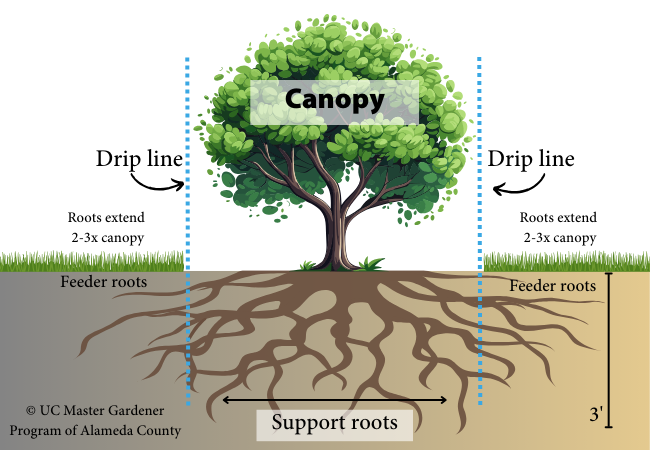
8 tips on watering trees
Excerpted with minor modifications from Tips on Watering Trees
-
Keep tree trunks dry. Trunks should not come into contact with water from sprinklers or hoses.
-
Apply the right amount of water at the right time.
-
Water newly planted trees regularly for a full season Many newly transplanted landscape trees die from the soil drying out too much between waterings because their root systems are small and need to be kept moist for a full growing season. Water newly planted trees regularly.
-
Water newly planted trees, including drought-tolerant species too. This schedule of regularly watering newly planted trees holds true for drought-tolerant species as well as those that require more water. Once plants become well rooted they should be watered less often but for longer periods of time. Established drought-tolerant trees will be able to go longer between waterings than those trees with moderate- or high-water needs
-
Water halfway to the dripline and beyond. Since tree roots spread outward as well as downward, water should be applied from mid-dropline and beyond the dripline of the tree.
-
Most established trees need water too. Most trees in California need supplemental irrigation above and beyond the naturally occurring rains, especially in times of drought. Water established trees less often but more deeply to encourage deep rooting and structural balance above and below ground. Be very careful if watering established native oaks since summer water can be detrimental to native oaks.
-
Trees need to be watered slowly and deeply. If you use a garden hose, apply the smallest trickle of water slowly, moving the hose every few hours to water the entire area around the tree. The deep watering encourages roots to grow downward and helps prevent sidewalk damage.
-
Do NOT water trees on the same irrigation/drip system as those used for lawns and groundcovers. The light, frequent watering every few days that is appropriate for lawns/groundcovers discourages the deep growth of tree roots.
Other tips for watering fruit trees and California natives
Watering fruit trees including citrus and avocados
Watering correctly is essential to the production of fruit and allows trees to keep a natural resistance to fungal diseases. This link https://ipm.ucanr.edu/homegarden/irrigating/ has more specific watering information on different trees including citrus, avocados and other fruit trees.
Watering of California natives
The vast majority of California's native plants are well-adapted to California's wet winter and summer dry climate, but even well-established native plants may need an occasional deep watering during hot, dry periods, perhaps one or two deep waterings over the summer. https://calscape.org/watering-native-plants
Tip: Don't water your ceanothus during the summer. Once established, summer watering may kill the plant. There are varieties of salvia that also don't like summer watering. Review watering guidelines by variety.
Watering established native California oak trees
“Even though oaks are known to be drought tolerant, summer irrigation may be beneficial to oak trees, especially during periods of prolonged drought, if water is kept at least 3 m (10 ft.) away from tree root crowns, or applied in the outer two-thirds of the root zone.” https://oaks.cnr.berkeley.edu/summer-irrigation-of-established-oak-trees/
Make sure California Oaks have a chance to dry out between waterings.
Common problems with water management
UC IPM, the statewide integrated pest management program has a very useful and detailed site on environmental disorders that focuses on the water management and pest problems. The information from that site formed the backbone of this section. Too little or too much water, the timing of water irrigation, and the downside of dripping, ponding, spraying water are all covered.
Water deficit
Symptoms: Leaves may droop, yellow, wilt, or drop prematurely. Severe, prolonged water deficit leads to shoot and branch dieback and, in some cases, bark cracking and trunk bleeding may occur. Mild but prolonged moisture deficit results in fewer flowers, fruit, slower growth, smaller leaves and increased sensitivity to pests. Plants stressed by drought are more susceptible to damage from mites, certain leaf-sucking insects, and most wood-boring insects
Management: Deep water your trees and shrubs by trickle watering, watering slowly for perhaps two hours. Water tree away from trunk, midway between trunk and dripline where the leaves end and rain drips off the tree, getting the water down to the roots that are often 12-18 inches or more below the surface.
Even trees that did fine without summer water in past years may need an occasional deep watering every month or two during extended hot weather.
Excess soil moisture
Symptoms: Over-irrigation has symptoms similar to those of underwatering. (See above.) Prolonged exposure to excess moisture results in roots dying, and plants become unable to take up water, resulting in symptoms similar to those of underwatering. Root decay pathogens such as Dematophora and Phytophthora spp. are present in many soils, yet usually become damaging only when excessively wet soil conditions favor them.
Management: Determine the cause of excess water. Soil that holds water too long can be improved by the addition of compost and other organics. The grade that causes water to pool or hold water for a long period can be altered. Change the irrigation schedule to adjust for changing seasons. If flooding of an area happens due to extended rains, drain the area when possible.
Water placement
Water dripping, ponding or spraying near the base of the trunk of a tree or shrub are primary causes of root and crown diseases. Soggy soil around the root collar, where the root and trunk join, promotes. Splashing water spreads fungal spores and splashing wets foliage, promoting leaf and fruit diseases such as anthracnose, brown rot, leaf spots and rust.
Seasonal timing
The seasonal timing of irrigation is important in disease development. Some California native trees may need summer water in drought years, but are sensitive to overwatering. For example, oak root fungus, Armillaria mellea, is present in dead or living roots in many soils, and it becomes active when soils are warm and moist. When people water native oaks frequently during the summer, moist roots and warm soils work together to predispose oaks and many other species to infection and death by oak root fungus.
Resources:
- Center for Landscape and Urban Horticulture
- Canopy - Healthy Trees, Healthy Communities
- Irrigation of trees and shrubs
- Irrigating fruit and shade trees and shrubs
- Landscape Tree Irrigation 101
- Oak Root Fungus
- Online Tools from UC IPM for Plant Problem Identification
- Root and Crown Rot
- Summer Irrigation of Established Oak Trees by UC Oaks
- Tips on Watering Trees
- University of California Integrated Pest Management (UC IPM)
- Water Management and Pest Problems from UC IPM
- Water Use Classification of Landscape Species ( UC Davis WUCOLS)
- UC Oaks - summer-irrigation-of-established-oak-trees/
- Watering Native Plants by Calscape
Have a gardening question? We'll help. You can reach us by:
-
Emailing acmg@ucanr.edu. Please include a photo of the problem, if you can, plus your name, phone number, city and a description of the problem.
-
Using our online form.
-
By phone, during our office hours, 10 am to noon Wednesday and 11 am to 1 pm Thursday: 510-670-5645. At other times, please leave a message and we'll return your call during our office hours.
-
In person at our Hayward office, during our office hours, only by appointment.
- Author: Linda Carloni
Tomatoes are one of our most popular and best-loved garden plants, but they do have their issues, which vary depending on variety, climate, soil, time of the season and your overall garden environment. Problems may happen despite the best care you can give them. This blog focuses on managing tomato problems common in Alameda County in mid-summer.
The problems are sorted by where you will first see it appear on the plant. The problem may also cause symptoms on other parts of the plant.
Tomato Problems Seen on Leaves
Early blight
-
Damage. Early blight symptoms include black or brown spots, not quite half an inch wide on leaves, stems, or fruit. Leaf spots are leathery and frequently have concentric rings. The spots generally appear on the oldest leaves, at the bottom of the plant. Early blight tends to crop up whenever the leaves become wet and can't dry off quickly. Early blight is more common in coastal regions because of fog, humidity and frequent cool weather.
-
Management/Prevention. The most important action is to avoid overhead watering. Water the soil, not the plant. Try to water early in the morning, so any water on the leaves has a chance to evaporate. Cut off the damaged leaves, so long as you can still retain a good canopy.
Late blight
-
Damage. Late blight occurs most often in coastal areas. Leaf damage starts as spots (of various colors) that look water-soaked and are surrounded by yellowish areas. This progresses to curled, tannish and dead leaves. This blight, too, is encouraged by wet leaves.
-
Management/Prevention. Again, the most important action is to avoid overhead irrigation. Copper fungicides may provide control if applied at the first sign of infection and reapplied every 7 to 10 days. Promote air circulation, prune the plant if needed to get airflow. The Phytophthora fungus that causes late blight spreads easily, so carefully dispose of all debris from infected plants once you have harvested. The spores can spread among your nightshades (tomatoes, tomatillos, peppers, eggplant, potatoes, and other plants in this family. ).
Powdery mildew
-
Damage. Powdery Mildew looks different on tomato leaves than on many vegetables. On tomato leaves, the fungus starts as yellow blotches, which progress to brown. There may or may not be the fuzzy whitish/grayish patches common on other vegetables. In severe cases, you can sometimes see mildewed spots on the main stem.
-
Management/Prevention. Warm days and cool nights and temperatures from 68° to 86°F benefit the fungus. Fog encourages it; higher temperatures may kill it. Powdery mildew grows best in shady conditions, so planting in the fullest sun you can find can help prevent it. Severe infestations may be managed with sulfur-based pesticides, some of which qualify for organic treatment. Always follow the package instructions when you apply any pesticide.
Whiteflies
-
Damage. Whiteflies damage the plant by piercing and sucking sap out of the leaves and stems. The leaves may turn yellow, appear dry or fall off. Whiteflies excrete a sticky substance called honeydew that can attract a dark sooty mold, impairing the leaves' photosynthesis and stunting growth.
-
Management/Prevention. Once a whitefly population is established, it can be hard to manage, so prevention and early response are most important. In many gardens, whiteflies are suppressed by their natural insect enemies. Cultivating these desired insects requires no use of broad-spectrum insecticides (like organophosphates, carbamates, and pyrethroids) and managing ants. Broad-spectrum insecticides, particularly systemic insecticides, will kill many natural insect enemies that you want, as well as the ones you don't want. Managing ants is important b/c the ants will protect insects that cause honeydew (which the ants eat) against their natural enemies, preventing them from doing their jobs.
-
Whiteflies can also be discouraged by reflective mulch (paper, plastic or fabric), which can be home-made or purchased in rolls. Small numbers of whiteflies can also be managed by hosing the plants down by spraying with the hose; multiple sprays may be needed. It can be difficult to effectively manage whiteflies with less-toxic oils and soaps, because only the whiteflies that the spray touches are affected.
Verticillium and Fusarium Wilts
-
Damage. Verticilium wilt is signaled by yellowing in the older leaves and wilting of shoot tips during the warmth of the day. Leaves start to curl up and often fall. Wilting becomes worse and the plant's condition becomes quite poor; it may die. For Fusarium wilt, early symptoms are bright yellow leaves, generally just on one side or one branch, often on only one side of the leaf. As it progresses, the foliage yellows, wilts and then turns brown. The entire plant dies. Both are widespread. Fusarium affects tomatoes; verticillium affects many garden plants.
-
Management/Prevention. Both Fusarium and Verticillium are caused by soil-borne fungi that affect the plant through the roots and disrupt the tissues that conduct water through the plant. Nothing can be done for tomatoes already infected with one of these two wilts. No fungicides are available to control these diseases. Even worse, these wilts can live in the soil for many years to infect susceptible new plants - tomatoes, potatoes, tomatillos, eggplant, peppers and many more. The best prevention is to remove all debris from infected plants, then use resistant plant varieties. You can determine if the variety is resistant by reading the plant label or seed packet, on which:
-
V means resistance to Verticillium,
-
F to Fusarium and
-
N to nematodes.
If you live in an area warm enough, soil solarization can help clean up the soil. To solarize, you cover an area with clear plastic for 4 to 6 weeks during a hot period of the year when the soil receives direct sunlight.
Leaf rolling
-
Damage. Tomato leaves curling upward.
-
Management and prevention. Tomato leaf curl can have many causes, so the first course of action is to determine why it's happening.
-
In spring when the weather is still cool and wet, the leaves may become firm and leathery and curl up. If this is the cause, the symptoms will resolve with no lasting damage when the weather warms and the soil dries.
-
If it's a very hot afternoon, but the soil is still damp an inch and more down, the tomato may just be unable to take in enough water to offset the water being lost through the underside of the leaves. The leaves should uncurl in the evening with no lasting damage. But if it's hot and the soil is dry, it's time to water.
Unfortunately, there are more serious causes of upward leaf roll - be sure to check a few of the rolled leaves to make sure there isn't an insect or caterpillar cocoon in there. Leaf curl can also be a symptom of overwatering leading to root rot, or an early sign of verticillium, so continue monitoring.
Less common leaf issues
-
Aphids can cause curling, yellowing and distortion of leaves, as well as a black mold on a sticky residue they excrete. You'll typically see the tiny insects as well. Hosing leaves down and beneficial insects can reduce this problem. Comprehensive information on aphid management
-
Viruses tend to cause mottling - yellow, white or light green - on the leaves, and may cause leaf distortion. Tobacco mosaic virus
-
Flea beetles feed on leaves, leaving tiny pits or small holes. A bad infestation can cover leaves with bleached pitted areas. This is generally the most serious in seedlings, which can be covered when young to prevent damage. More on flea beetles
Tomato Fruit Damage Causes
Hornworms
-
Damage. To my mind, hornworms are the worst tomato problem. They can break your heart, chomping up that almost ripe tomato you were planning to eat next week.
-
Hornworms grow to be large striped green caterpillars and have a small horn on the rear end. Despite their size, they are surprisingly hard to find. The first sign you see may be large black or dark green droppings under the plant. Hornworms also chew up the leaves.
-
Management and prevention. Hornworms can be snipped with shears or squished with a foot. Crows and chickens love them for dinner. The pesticides Bt (Bacillus thuringinesis) and spinosad can be effective when the caterpillars are small. Natural enemy insects can keep the population down too. Monitoring is crucial to catch the problem early.
Blossom End Rot
-
Damage. Blossom end rot is caused by environmental conditions; generally those affecting the water and calcium in the fruits as they develop. It causes a brown, sunken, leathery spot at the blossom end of the fruit, and is most common in sandy soils.
-
Management and prevention. The problem is aggravated by high soil salt content and inconsistent watering. To minimize the problem, monitor your soil (especially if the plants are in pots) to make sure the root zone remains moist, and water only when it is getting dry. If your soil tests as deficient in calcium (most do not), adding calcium to the soil may help, but a calcium deficit is usually not the cause. Don't over-fertilize. For prevention, add lots of compost to your soil when planting to help retain water.
Sunscald
-
Damage. While tomatoes like the sun, they can still get “burned.” Overexposure to sunlight can cause the fruit to become tan and tough on the side where the sun hits. This is more of a problem for plants that have a lot of bright afternoon sun or have been seriously pruned.
-
Management and prevention. Enough (but not too much) moisture and fertilizer are important to keep the leaves growing well to shade the fruit. Avoid too much pruning as well. If the plants get full, intense afternoon sun, consider adding a bit of afternoon shade with an umbrella or shade cloth.
Fruit cracking / Catfacing
-
Damage. The surface of the fruit can crack: in a spoke-like pattern out from the stem, in a circular pattern at the stem end, or at the blossom end.
-
Management and prevention. These tend to be caused by environmental extremes: rain following long dry periods; high temperatures coupled with high soil moisture, resulting in very fast growth; wide fluctuations in soil moisture; abnormally hot or cold conditions. Many of these we have no control over, but the following can help: choosing varieties adapted to your climate; keeping the soil evenly moist; heavy mulching (3 to 4 inches, but always at least a couple of inches away from the stem) to moderate the soil temperature; maintaining good leaf cover.
Symptoms Affecting the Whole Plant
Failure to Thrive
Sometimes tomato plants just don't do well. There may be loss of vigor, with the plant not growing as well as the others nearby; smaller leaves and fruit than the neighboring plants; wilting even when the soil is moist (without leaf problems); and/or overall leaf yellowing.
Possible causes include problems in care and:
-
Root-knot nematodes (microscopic roundworms)
-
You can confirm root-knot nematodes by looking at the roots or viewing soil under a microscope. Root-knot nematodes cause distinctive galls on the roots, pictured above. It's difficult to manage nematodes. Prevention steps: only using nematode-free plants from reliable nurseries and only planting nematode-resistant varieties (marked N on the plant tag or seed packet). To keep nematodes from spreading, don't move nematode-infested plants and don't allow irrigation water to spread from an infested area. To reduce the level of nematodes, a combination of planting resistant varieties, fallowing (leaving the soil empty but moist and free of weeds) and soil solarization (if you live in a warm enough area) can be effective. More info on this technique.
Failure to fruit in summer
This very disappointing problem can have several causes:
-
Too much nitrogen fertilizer
-
Not enough light - tomatoes really need at least 6 hours of sunlight each day
-
Cool nights - under 55 degrees
-
Consistent high daytime heat - over 90 degrees.
-
Not enough warmth - Tomato plants thrive in daytime temperatures between 80 and 90 degrees.
The last three problems can be greatly mitigated by planting an appropriate variety. Some varieties withstand heat better. The Marin Master Gardeners recommend Heatmaster, Solar Fire, Summer Set and Phoenix for hot areas. For colder climates, varieties with fewer days to maturity (including most cherry tomatoes) tend to do better.
Major sudden damage
-
If you come out to your garden one afternoon and there are significant holes in the ripe tomatoes, it may be a mammal.
-
Particularly if the tomato is removed from the plant, your pest may be birds or a mammal. Rabbits, squirrels, birds and rats are known tomato munchers.
-
Hornworms cause large but shallow damage. Here is a guide to figuring out which critter it is and how to manage them.
You are unlikely to see all of these problems in one season; maybe you will be fortunate and you won't see any. Hopefully, whatever does occur will be quickly managed!
References
- Tomato plant problems and how to solve them by the Marin Master Gardeners
- Tomato diseases in the home garden by the Contra Costa Master Gardeners
- UC IPM for home gardens, tomatoes
Have a gardening question? We'll help. You can reach us by:
- Emailing acmg@ucanr.edu. Please include a photo of the problem, if you can, plus your name, phone number, city and a description of the problem.
- Using our online form.
- By phone, during our office hours, 10 am to noon Wednesday and 11 am to 1 pm Thursday: 510-670-5645. At other times, please leave a message and we'll return your call during our office hours.
- In person at our Hayward office, during our office hours, only by appointment.
- Author: Linda Carloni
Tomatoes are one of our most popular and best-loved garden plants, but they do have their needs. Because a tomato crop can be so deliciously rewarding, many of us are happy to devote extra energy to manage this wonderful crop. It's warm, and your tomatoes are growing, starting to flower and fruit. This post discusses what you should be doing now to take care of those plants. If you have already seen a problem on your tomatoes, you may want to go first to the companion piece - Managing Midsummer Tomato Problems.
Summer Tomato Care
Watering
Enough but not too much is the key. While tomato seedlings should be kept moist all the time when planted, after 3 to 4 weeks you should taper down. Established plants should be watered just after the top few inches of soil have dried. Water so that the whole root zone becomes thoroughly moist. Temperature plays a huge role in how much water your plant needs. Think of the difference in temperature, and thus water needs between the cities of Pleasanton and Alameda, just in our county! How often and how much to water also depends on the type of soil, whether it is windy, and the depth to which the plant has rooted. Remember, plants in pots will need to be watered more often because there is less soil from which the roots can draw water and because pots dry out faster.
A hand-held moisture meter (typically 6”to 8”in length) can be very helpful in determining when to water. These are not precise, but are widely available and relatively inexpensive and can give you a general idea. Even simpler, you can stick your finger in the soil several (3 to 6) inches down and see if the soil is moist. Overwatering can cause leaf wilting, root rot, and catfacing or cracking of your tomatoes. Underwatering causes leaves to look wilted, blossoms to dry up and fall off, and growth to slow. Inconsistent watering exacerbates blossom end rot. So it's important to put in the extra effort to get it right.
To keep that water where you want it, check the mulch around your plant. A few inches of mulch on the surface, starting 2 or three inches from the stem, really helps diminish loss from evaporation, helping you achieve that even moisture you want.
Take care not to get the leaves wet, which can lead to leaf fungal diseases. Water the soil, not the plant.
Support
You probably put a tomato cage around your plants or put in a stake or stakes to tie them too. Great job - all tomatoes need support! In the summer, you need to check (more than once) to make sure that initial support remains adequate. As the plants grow, they send out lots of branches that will try to sneak out of their supporting structure. This is particularly an issue with indeterminate vining plants, but the bushier determinants can also evade your efforts. Standard commercial cages are frequently insufficient for a large and vigorous tomato plant. To add additional support, you can gently tie errant branches to the existing supports and/or add additional stakes and tie to them. Heavy-duty cages and super large heavy-duty cages (photo above) provide a lot more support.
Pruning
Why prune?
-
Any leaves at the bottom of the plant that are touching or almost touching the ground should be pruned. Tomatoes can contract diseases through leaves that touch the ground. These low branches occur because tomatoes need to be planted deep. A good rule of thumb is to remove branches that start less than four inches above the ground.
-
Determinate tomatoes should not be pruned except for the lowest branches as described above. All the fruit on determinants comes at once, and pruning would sacrifice some of that fruit.
-
Always make sure you keep enough leaves for photosynthesis, which takes place in the leaves and feeds the plant.
-
You also need enough leaves to shade the tomatoes to avoid sunscald.
-
If you grow in an area where the leaves may get damp from rain or fog, pruning the plant for air circulation will help minimize the tomato maladies exacerbated by humidity and wet leaves. In Alameda County, this is particularly important in the foggy moderate climate Bayside areas.
-
If the plant becomes very dense, you may need to prune out some branches in the middle so that sunlight can penetrate to the inside of the plant.
Other than the reasons above, it's really a question of personal preference.
-
Pruning gives you the ability to train the tomatoes up in a narrow shape. This lets you plant more tomatoes in a given space.
-
Pruning gives you larger early tomatoes, although fewer tomatoes overall.
-
Pruning directs more energy to making the fruit rather than growing foliage.
-
If you are supporting a large indeterminate tomato using a standard commercial tomato cage or staking, you may need to prune so that the cage or stakes can carry the weight of a fully laden plant.
However,
-
Pruning is more work!
-
Pruning may make the tomatoes more susceptible to sunscald.
Here's a nice video on pros and cons of pruning from a sister Master Gardener program
Fertilizing
Even if you've fertilized your tomatoes when they were planted (recommended), tomatoes generally need additional fertilizing, starting once they have flowered and set some fruit. When that happens, add some tomato fertilizer that has potassium and phosphorus as well as nitrogen. Always follow the package directions. Make sure the soil is thoroughly moistened, scratch the fertilizer into the top part of the soil without disturbing the roots, and water it in. Depending on how long your tomato is bearing and growing, you may want to repeat this, but not more often than every four to six weeks.
Resources on fertilizing:
- Fertilizing 101
- Is it time to fertilize?
- Feeding the soil, not the plant
- General information on fertilizing and soil from California Garden Web
Following the fertilizing instructions help you keep your tomatoes vigorous and growing. But despite your best efforts, pests, diseases and other problems happen. Here's a guide to managing those problems.
General Tomato Resources
Care
Selection







